change time OLDSMOBILE SILHOUETTE 1996 Owners Manual
[x] Cancel search | Manufacturer: OLDSMOBILE, Model Year: 1996, Model line: SILHOUETTE, Model: OLDSMOBILE SILHOUETTE 1996Pages: 372, PDF Size: 19.39 MB
Page 4 of 372
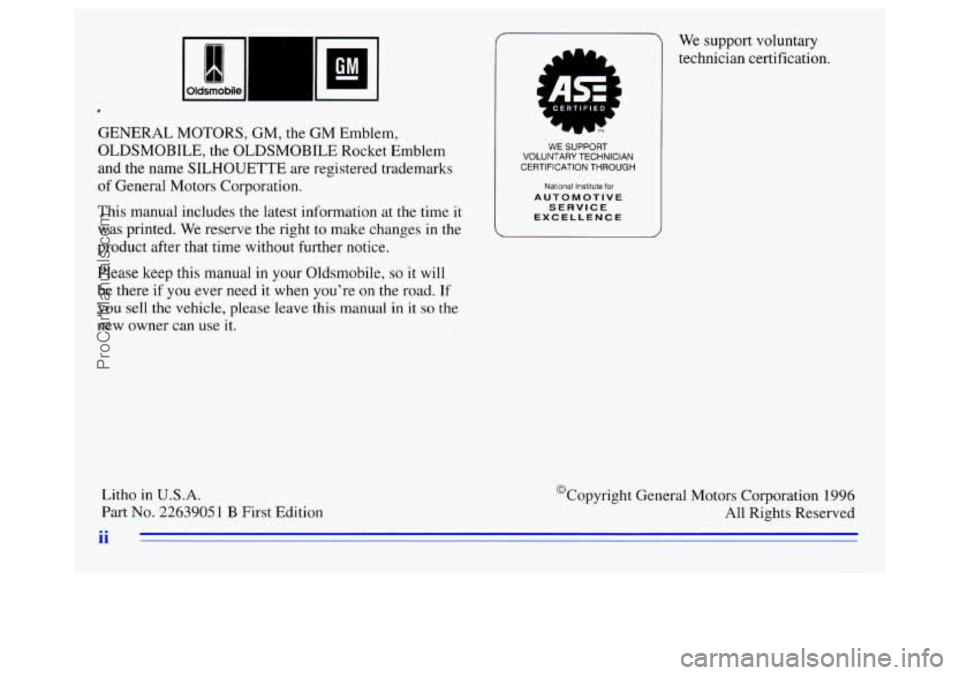
GENERAL MOTORS, GM, the GM Emblem,
OLDSMOBILE, the OLDSMOBILE Rocket Emblem
and the name SILHOUETTE are registered trademarks
of General Motors Corporation.
This manual includes the latest information at the time it
was printed. We reserve the right to make changes in the
product after that time without further notice.
Please keep this manual in your Oldsmobile,
so it will
be there if you ever need it when you’re on the road. If
you sell the vehicle, please leave this manual
in it so the
new owner can use it.
Litho in U.S.A.
Part No. 22639051
B First Edition
WE SUPPORT VOLUNTARY TECHNICIAN
CERTIFICATION THROUGH
National Institute for
AUTOMOTIVE SERVICE EXCELLENCE
We support voluntary
technician certification.
@Copyright General Motors Corporation 1996 All Rights Reserved
ii
ProCarManuals.com
Page 74 of 372

If you have the optional power sliding door (see “Power
Sliding Door” later
in this section), your remote
transmitter will have
a third button that has a van
symbol on
it. Press it to open or close the sliding door.
If the sliding door is locked, first press the unlock
symbol twice to unlock all doors, then press the van
symbol
to open the sliding door.
You can operate the power sliding door with
the remote
transmitter only when the power sliding door
ON/OFF
switch on the overhead console is in the ON position.
atchin- n-.smitter(s) To Your Vehicle -
Each
key chain transmitter is coded to prevent another
transmitter from unlocking your vehicle.
If a transmitter
is lost or stolen, a replacement can be purchased through
your retailer. Remember
to bring any remaining
transmitters with you when you go to your retailer.
When
the retailer matches the replacement transmitter to
your vehicle, any remaining transmitters must also be
matched. Once the new transmitter is coded, the lost
transmitter will not unlock your vehicle. Each vehicle
can have only four transmitters matched to it.
n 1tt acement
Under-normal use, the battery in your key chain
transmitter should last about two years.
You can tell the battery is weak if the transmitter won’t
work at the normal range in any location.
If you have to
get close to your vehicle before the transmitter works,
it’s probably time to change the battery.
ProCarManuals.com
Page 89 of 372

NOTICE:
Holding your key in START for longer than
15 seconds at a time will cause your battery to be
drained much sooner. And the excessive heat can
damage your
starter motor.
2.
3.
If it doesn’t start right away, hold your key in
START. If it doesn’t start in three seconds (or starts
but then stops), push the accelerator pedal about
one-quarter
of the way down for 12 more seconds, or
until it starts.
If your engine still won’t start (or starts but then
stops), it could be flooded with too much gasoline.
Try this:
Wait
15 seconds to let the starter motor cool down.
Then push your accelerator pedal all the way to the
floor. Hold it there. Then hold the key
in START.
This clears the extra gasoline from the engine. When
the engine starts, let go of the key and the accelerator
pedal.
If the engine still doesn’t start, wait another
15 seconds and repeat this step.
NOTICE:
Your engine is designed to work with the
electronics in your vehicle.
If you add electrical
parts or accessories, you could change the
way
the engine operates. Before adding electrical
equipment, check with your retailer.
If you don’t,
your engine might not perform properly.
If you ever have to have your vehicle towed, see
the part
of this manual that tells how to do it
without damaging your vehicle. See “Towing
Your Vehicle” in the Index.
2-25
ProCarManuals.com
Page 151 of 372
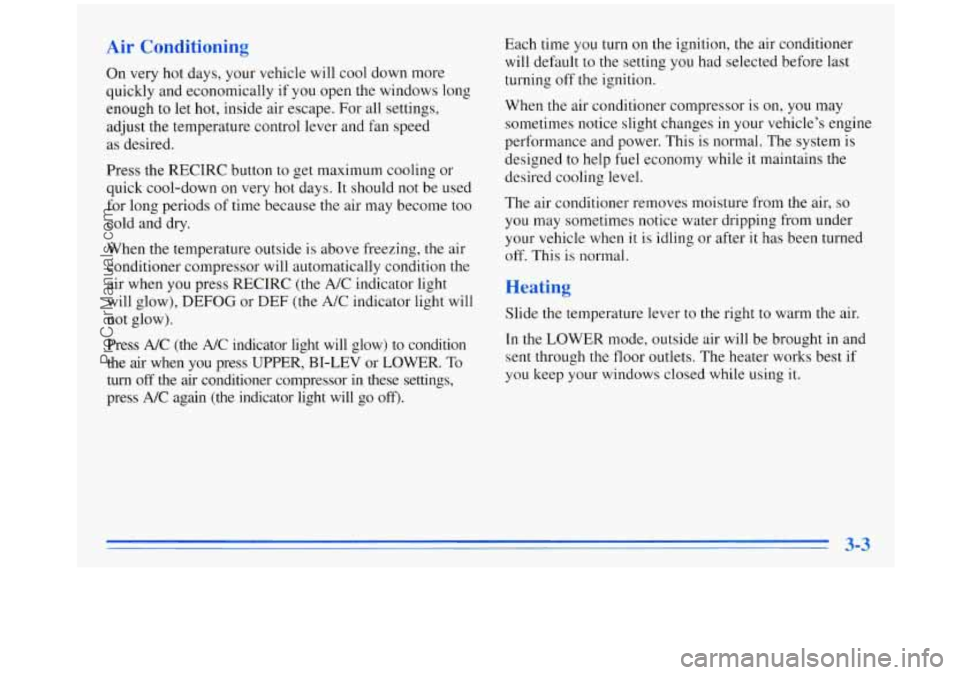
On very hot days, your vehicle will cool down more
quickly and economically if you open the windows long
enough to let
hot, inside air escape. For all settings,
adjust the temperature control lever and fan speed
as desired.
Press the RECIRC button
to get maximum cooling or
quick cool-down on very hot days. It should not be used
for long periods of time because the air may become too
cold and dry.
When the temperature outside is above freezing,
the air
conditioner compressor will automatically condition the
air when you press RECIRC (the A/C indicator light
will glow),
DEFOG or DEF (the A/C indicator light will
not glow).
Press A/C (the
A/C indicator light will glow) to condition
the air when you press UPPER, BI-LEV or LOWER. To
turn
off the air conditioner compressor in these settings,
press A/C again (the indicator light will go
off>.
Each time you turn on the ignition, the air conditioner
will default to the setting you had selected before last
turning off the ignition.
When the air conditioner compressor is on,
you may
sometimes notice slight changes
in your vehicle’s engine
performance and power. This is normal. The system
is
designed to help fuel economy while it maintains the
desired cooling level.
The air conditioner removes moisture from the air,
so
you may sometimes notice water dripping from under
your vehicle when
it is idling or after it has been turned
off. This is normal.
T’
Slide the temperature lever to the right to warm the air.
In the LOWER mode, outside air will be brought
in and
sent through
the floor outlets. The heater works best if
you keep your windows closed while using
it.
ProCarManuals.com
Page 165 of 372

Finding a Station
AM-FM: Press this button to get AM or FM. Your
selection will show on the display.
If the station is in
stereo, ST will show on the display.
Your radio has AMAX. With an AMAX-certified
receiver, your radio can produce quality AM sound
comparable to FM stereo. AMAX reduces noise without
reducing the high frequencies you need for the best
sound. In addition to improved sound quality, AMAX
includes more stations
on the AM band. You don’t have
to do anything to your Delco/GM radio because AMAX
is automatic.
TUNE: Press the up arrow to tune in radio stations
higher on the AM or FM band. Press the down arrow
to tune in radio stations lower on the band.
SEEK: Press this button to tune to the next higher
station and stay there.
SCAN: Press this button to hear each station for a few
seconds. The radio will
go to a station, stop for a few
seconds, then
go on to the next station. Press SCAN
again if you hear something you like and want to stay
there. SCAN will appear on the display while scanning.
PUSHBUTTONS: The five pushbuttons let you return
to your previously played stations. You can set up to
10 stations (five AM and five FM).
1.
2.
3.
4.
S
Find the station you want by using TUNE.
Press SET. (The SET indicator will appear briefly
on
the display.)
Press
one of the five pushbuttons, within five
seconds. Whenever you press that button, the station
you set will return.
Repeat the steps for each pushbutton.
BASS: Press the top of the button to hear more bass and
the down arrow to hear less bass. Press the center of the
button for the factory-preset position.
TREB: Press the up arrow to hear more treble and the
down arrow to hear less treble. Press the center of the
button for the factory-preset position. TREB will appear
briefly on the display whenever TREB is pressed.
Ldjusting the Speakers
BAL: This four-way control adjusts the leftlright and
fronthear speaker balance to your individual taste.
When you change either adjustment, the bottom of the
digital screen will display
the point of balance you have
selected. Press the left and right or front and rear buttons
at the same time to select
the factory-preset position.
3-17
ProCarManuals.com
Page 182 of 372
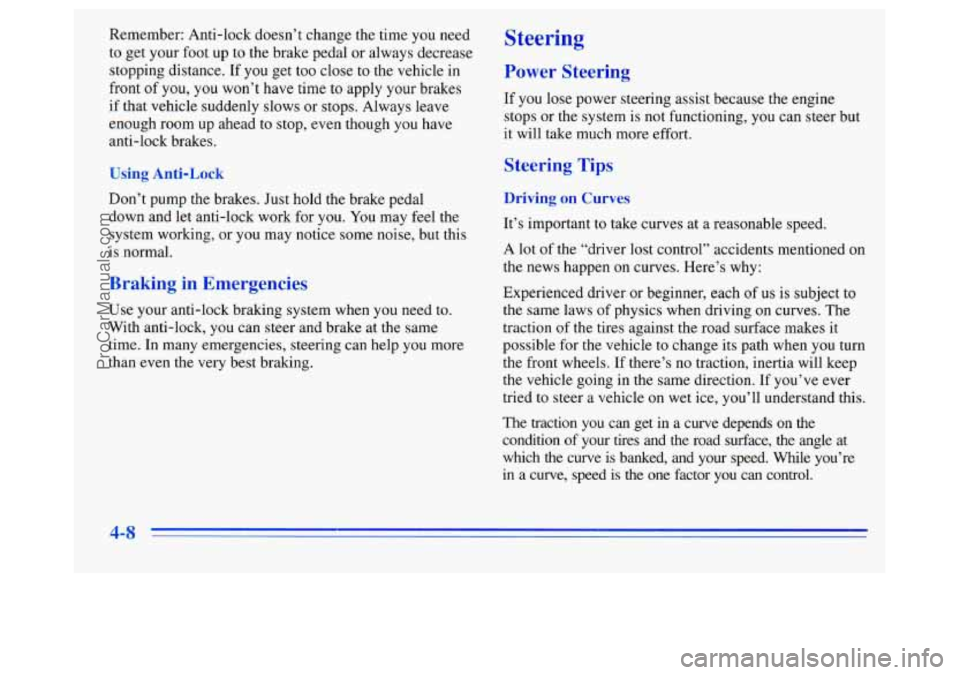
Remember: Anti-lock doesn’t change the time you need
to get your foot up to the brake pedal or always decrease
stopping distance. If
you get too close to the vehicle in
front of you, you won’t have time to apply your brakes
if that vehicle suddenly slows or stops. Always leave
enough room up ahead
to stop, even though you have
anti-lock brakes.
Using Anti-Lock
Don’t pump the brakes. Just hold the brake pedal
down and let anti-lock work for you. You may feel the
system working, or you may notice some noise, but this
is normal.
Braking in Emergencies
Use your anti-lock braking system when you need to.
With anti-lock, you can steer and brake at the same
time.
In many emergencies, steering can help you more
than even the very best braking.
Steering
Power Steering
If you lose power steering assist because the engine
stops or the system is not functioning, you can steer but
it will take much more effort.
Steering Tips
Driving on Curves
It’s important to take curves at a reasonable speed.
A lot of the “driver lost control” accidents mentioned on
the news happen on curves. Here’s why:
Experienced driver or beginner, each
of us is subject to
the same laws of physics when driving on curves. The
traction of
the tires against the road surface makes it
possible for the vehicle to change its path when
you turn
the front wheels. If there’s
no traction, inertia will keep
the vehicle going in the same direction. If you’ve ever
tried to steer a vehicle
on wet ice, you’ll understand this.
The traction you can get in
a curve depends on the
condition of your tires and the road surface,
the angle at
which the curve is banked,
and your speed. While you’re
in a curve, speed is the one factor you can control.
4-8
ProCarManuals.com
Page 186 of 372
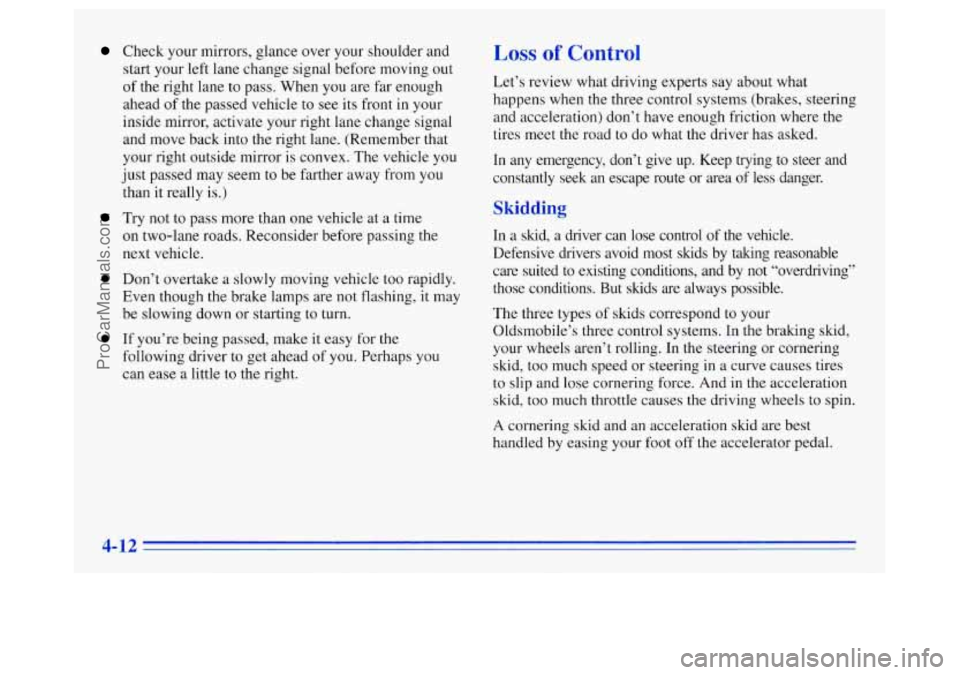
Check your mirrors, glance over your shoulder and
start your left lane change signal before moving out
of the right lane to pass. When you are far enough
ahead of the passed vehicle to see its front in your
inside mirror, activate your right lane change signal
and move back into the right lane. (Remember that
your right outside mirror is convex. The vehicle you
just passed may seem to be farther away from you
than it really is.)
Try not to pass more than one vehicle at a time
on two-lane roads. Reconsider before passing the
next vehicle.
0 Don’t overtake a slowly moving vehicle too rapidly.
Even though the brake lamps are not flashing, it may
be slowing down or starting to turn.
0 If you’re being passed, make it easy for the
following driver to get ahead of you. Perhaps you
can ease a little
to the right.
Loss of Control
Let’s review what driving experts say about what
happens when the three control systems (brakes, steering
and acceleration) don’t have enough friction where the
tires meet the road to do what the driver has asked.
In any emergency, don’t give up. Keep trying to steer and
constantly seek an escape route or area of less danger.
Skidding
In a skid, a driver can lose control of the vehicle.
Defensive drivers avoid most skids by taking reasonable
care suited to existing conditions, and by not “overdriving”\
those conditions. But skids are always possible.
The three types of skids correspond to your
Oldsmobile’s three control systems. In the braking skid,
your wheels aren’t rolling. In the steering or cornering
skid, too much speed or steering in a curve causes tires
to slip and lose cornering force. And
in the acceleration
skid, too much throttle causes the driving wheels to spin.
A cornering skid and an acceleration skid are best
handled by easing your foot off the accelerator pedal.
4-12
ProCarManuals.com
Page 202 of 372
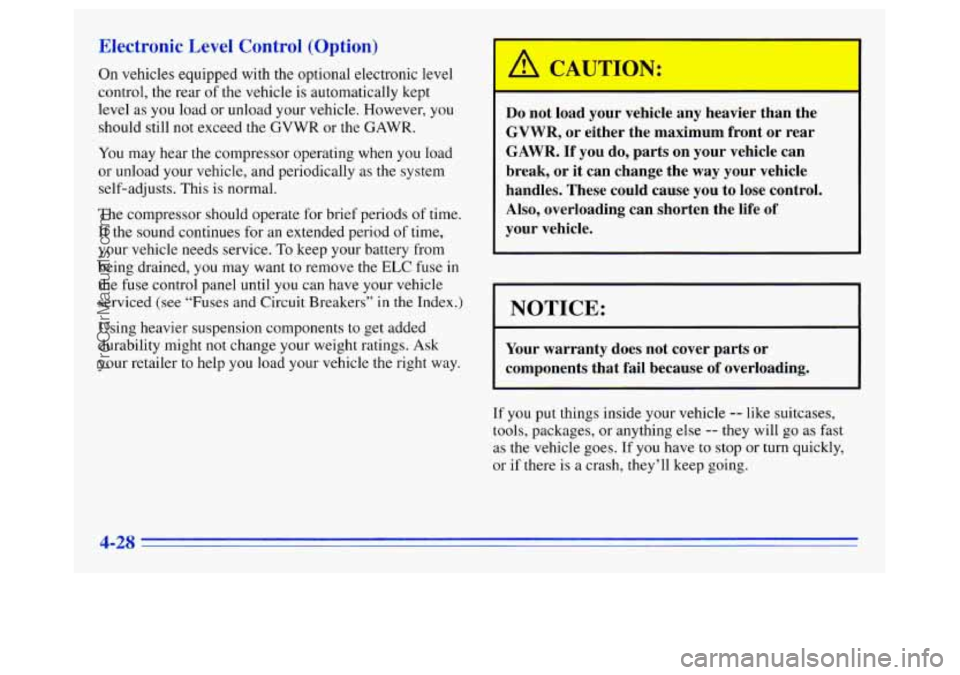
Electronic Level Control (Option)
On vehicles equipped with the optional electronic level
control, the rear of the vehicle is automatically kept
level as you load or unload your vehicle. However, you
should still
not exceed the GVWR or the GAWR.
You may hear the compressor operating when you load
or unload your vehicle, and periodically as the system
self-adjusts. This is normal.
The compressor should operate for brief periods of time.
If the sound continues for an extended period
of time,
your vehicle needs service. To keep your battery from
being drained, you may want to remove
the ELC fuse in
the fuse control panel until you can have your vehicle
serviced
(see “Fuses and Circuit Breakers’’ in the Index.)
Using heavier suspension components to get added
durability might not change your weight ratings. Ask
your retailer to help you load your vehicle the right way.
I 6% ,AUTIONr
Do not load your vehicle any heavier than the
GVWR, or either the maximum front or rear
GAWR.
If you do, parts on your vehicle can
break, or it can change the
way your vehicle
handles. These could cause you to lose control.
Also, overloading can shorten the life
of
your vehicle.
NOTICE:
Your warranty does not cover parts or
components that fail because of overloading.
If you put things inside your vehicle -- like suitcases,
tools, packages, or anything else -- they will go as fast
as the vehicle goes.
If you have to stop or turn quickly,
or
if there is a crash, they’ll keep going.
I
4-28
ProCarManuals.com
Page 204 of 372

Your vehicle can tow a trailer. To identify what the
vehicle trailering capacity is for your vehicle, you
should read the information in “Weight of the Trailer”
that appears later in this section. But trailering is
different than just driving your vehicle by itself.
Trailering means changes
in handling, durability and
fuel economy. Successful, safe trailering takes correct
equipment, and it has
to be used properly.
That’s the reason for this section.
In it are many
time-tested, important trailering tips and safety rules.
Many
of these are important for your safety and that of
your passengers.
So please read this section carefully
before you pull a trailer.
Load-pulling components such as the engine, transaxle,
wheel assemblies and tires are forced to work harder
against the drag
of the added weight. The engine is
required to operate at relatively higher speeds and under
greater loads, generating extra heat. What’s more, the
trailer adds considerably to wind resistance, increasing
the pulling requirements.
If You Do Decide To Pull A Trailer
If you do, here are some important points:
0
0
0
0
0
There are many different laws, including speed limit
restrictions, having to do with trailering. Make sure
your rig will be legal, not only where you live but
also where you’ll be driving.
A good source for this
information can be state or provincial police.
Consider using a sway control
if your trailer will
weigh
2,000 lbs. (900 kg) or less. You should always
use
a sway control if your trailer will weigh more
than
2,000 lbs. (900 kg). You can ask a hitch dealer
about sway controls.
Don’t tow
a trailer at all during the first 500 miles
(800 km) your new vehicle is driven. Your engine,
axle or other parts could be damaged.
Then, during the first
500 miles (800 km) that you
tow a trailer, don’t drive over
50 mph (80 km/h) and
don’t make starts at full throttle. This helps your
engine and other parts of your vehicle wear in at the
heavier loads.
You should use THIRD (D) (or, as you need to, a
lower gear) when towing a trailer. Operating your
vehicle
in THIRD (D) when towing a trailer will
minimize heat buildup and extend the life of
your transaxle.
4-30
ProCarManuals.com
Page 241 of 372
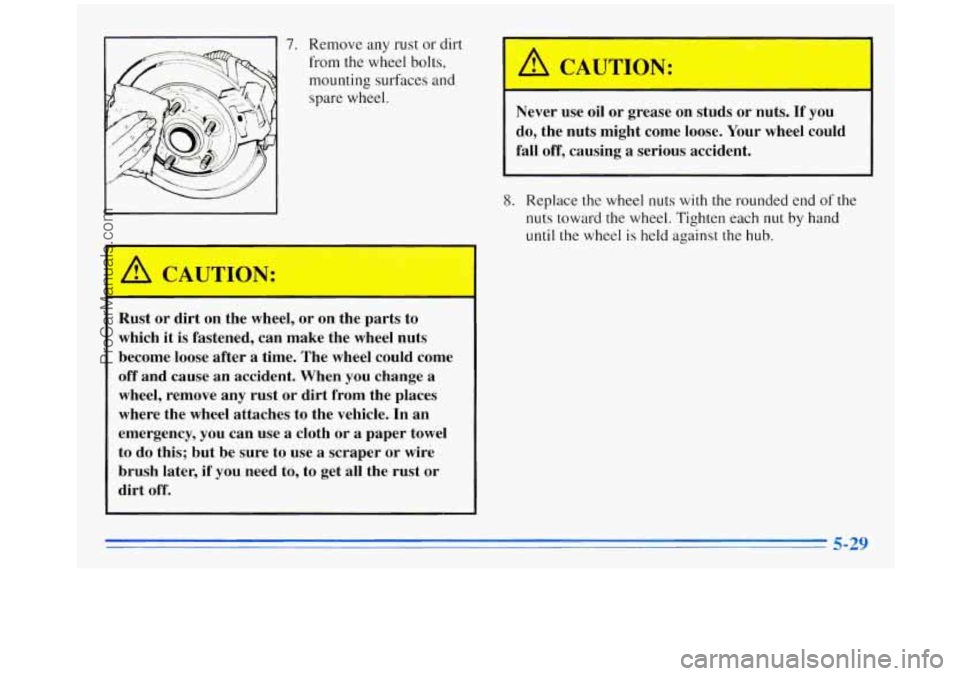
7. Remove any rust or dirt
from the wheel bolts,
mounting surfaces and
spare wheel.
FTA TION:
Rust or dirt on the wheel, or on the parts to
which it is fastened, can make the wheel nuts
become loose after a time. The wheel could come
off and cause an accident. When
you change a
wheel, remove any rust or dirt from the places
where the wheel attaches to the vehicle. In an
emergency, you can use a cloth or
a paper towel
to do this; but be sure to use
a scraper or wire
brush later, if you need to, to get all the rust or
dirt off.
8. Replace the wheel nuts with the rounded end of the
nuts toward the wheel. Tighten each
nut by hand
until the wheel is held against the hub.
7
I A CAUTION:
Never use oil or grease on studs or nuts. If you
do, the nuts might come loose. Your wheel could
fall off, causing a serious accident.
5-29
ProCarManuals.com